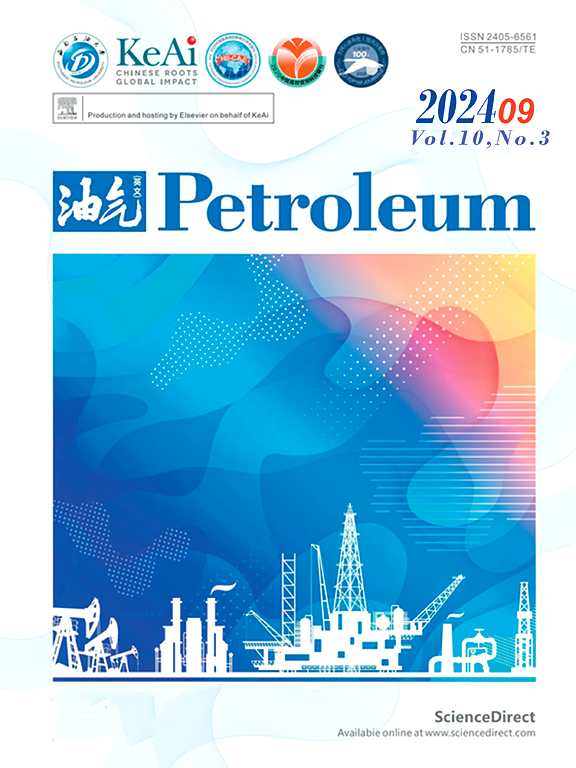Effect of potential determining ions on sulfonated polyacrylamide behavior during smart water-polymer injection into carbonate reservoirs
IF 4.2
Q2 ENERGY & FUELS
引用次数: 0
Abstract
In low salinity polymer flooding (LSPF), an advanced hybrid method for enhanced oil recovery (EOR), less attention has been given to the impacts of potential determining ions on polymer behavior in carbonate reservoirs. Therefore, seawaters spiked with divalent ions were used with sulfonated polyacrylamide (SPAM) polymer to investigate the effects of potential determining ions on SPAM performance in wettability alteration, polymer adsorption, carbonate surface charge, viscosity enhancement, emulsion type, and oil recovery. Among divalent anions and cations, only excess amounts of Mg2+ in a smart water-polymer solution could alter the wettability from oil-wet to neutral-wet and make the rock/brine zeta potential positive. Additionally, higher SPAM adsorption onto carbonate surfaces was observed as Mg2+ concentration was doubled, driven by interactions between sulfonate groups (–SO3−) and the positively charged rock surface. Conversely, excess SO42- impeded interactions between –SO3– and positively charged carbonate rock species, reducing SPAM adsorption. At 5000 ppm SPAM concentration, excess divalent ions increased solution viscosity due to the shielding effect, with the highest viscosity achieved by doubling Mg2+ concentration. However, at 10,000 ppm SPAM concentration, only SO42- improved viscosity, while Ca2+ and Mg2+ reduced the viscosity of smart water-polymer solutions. As for emulsions produced by smart water-polymer solutions, the presence of SPAM in smart water led to the production of water-in-oil (W/O) emulsions and increased the mean droplet size of water droplets due to the salt-out effect. According to the results obtained from calcite-coated micromodel flooding experiments, the ultimate oil recovery for SW + SPAM (5000 ppm) was 34.2%. Also, a two-fold increase in the Mg2+ concentration rose the oil recovery by 6.5%.
碳酸盐岩储层智能水聚合物注入过程中电位决定离子对磺化聚丙烯酰胺行为的影响
低矿化度聚合物驱(LSPF)是一种先进的提高采收率(EOR)的混合驱方法,但人们对碳酸盐岩储层中电位决定离子对聚合物行为的影响关注较少。因此,将加入二价离子的海水与磺化聚丙烯酰胺(SPAM)聚合物结合,研究电位决定离子对SPAM润湿性改变、聚合物吸附、碳酸盐表面电荷、粘度增强、乳液类型和采收率等性能的影响。在二价阴离子和阳离子中,智能水聚合物溶液中只有过量的Mg2+才能将润湿性从油湿性转变为中性湿性,并使岩石/盐水的zeta电位变为正电位。此外,在硫酸盐基团(-SO3−)与带正电的岩石表面相互作用的驱动下,当Mg2+浓度增加一倍时,在碳酸盐表面上观察到更高的SPAM吸附。相反,过量的SO42阻碍了- so3 -与带正电的碳酸盐岩之间的相互作用,减少了SPAM的吸附。在5000 ppm的SPAM浓度下,由于屏蔽效应,过量的二价离子增加了溶液粘度,当Mg2+浓度加倍时,溶液粘度达到最高。然而,在10,000 ppm的SPAM浓度下,只有SO42-提高了粘度,而Ca2+和Mg2+降低了智能水聚合物溶液的粘度。对于智能水-聚合物溶液生成的乳液,SPAM在智能水中的存在导致了油包水(W/O)乳液的生成,并且由于盐析作用,增加了水滴的平均液滴尺寸。根据方解石包覆微模型驱油实验结果,SW + SPAM (5000 ppm)的最终采收率为34.2%。此外,Mg2+浓度增加了两倍,原油采收率提高了6.5%。
本文章由计算机程序翻译,如有差异,请以英文原文为准。
求助全文
约1分钟内获得全文
求助全文
来源期刊

Petroleum
Earth and Planetary Sciences-Geology
CiteScore
9.20
自引率
0.00%
发文量
76
审稿时长
124 days
期刊介绍:
Examples of appropriate topical areas that will be considered include the following: 1.comprehensive research on oil and gas reservoir (reservoir geology): -geological basis of oil and gas reservoirs -reservoir geochemistry -reservoir formation mechanism -reservoir identification methods and techniques 2.kinetics of oil and gas basins and analyses of potential oil and gas resources: -fine description factors of hydrocarbon accumulation -mechanism analysis on recovery and dynamic accumulation process -relationship between accumulation factors and the accumulation process -analysis of oil and gas potential resource 3.theories and methods for complex reservoir geophysical prospecting: -geophysical basis of deep geologic structures and background of hydrocarbon occurrence -geophysical prediction of deep and complex reservoirs -physical test analyses and numerical simulations of reservoir rocks -anisotropic medium seismic imaging theory and new technology for multiwave seismic exploration -o theories and methods for reservoir fluid geophysical identification and prediction 4.theories, methods, technology, and design for complex reservoir development: -reservoir percolation theory and application technology -field development theories and methods -theory and technology for enhancing recovery efficiency 5.working liquid for oil and gas wells and reservoir protection technology: -working chemicals and mechanics for oil and gas wells -reservoir protection technology 6.new techniques and technologies for oil and gas drilling and production: -under-balanced drilling/gas drilling -special-track well drilling -cementing and completion of oil and gas wells -engineering safety applications for oil and gas wells -new technology of fracture acidizing
 求助内容:
求助内容: 应助结果提醒方式:
应助结果提醒方式:


